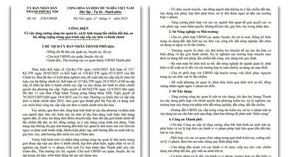In a significant move towards healthier eating, the Department of Health and Human Services (HHS) and the Food and Drug Administration (FDA) announced on April 22, 2025, a plan to phase out eight artificial food dyes and colorings from the American food supply by the end of next year. This initiative, spearheaded by HHS Secretary Robert F. Kennedy Jr., aims to eliminate petroleum-based synthetic dyes that have been linked to various health concerns.
During a press conference, Kennedy emphasized the urgency of the initiative, stating, "I just want to urge all of you, it's not the time to stop; it's the time to redouble your efforts, because we have them on the run now, and we are going to win this battle." He expressed confidence that within four years, most of these harmful products would be off the market or clearly labeled for consumers.
FDA Commissioner Dr. Marty Makary joined Kennedy at the announcement, detailing the steps the agencies plan to take. He stated that the FDA would revoke authorization for synthetic food colorings, including Citrus Red No. 2 and Orange B, and work with food companies to eliminate six remaining synthetic dyes used in products like cereals, ice creams, and snacks. The dyes targeted for elimination include Green No. 3, Red No. 40, Yellow No. 5, Yellow No. 6, Blue No. 1, and Blue No. 2.
Makary highlighted the long-term health implications of synthetic dyes, stating, "For the last 50 years, American children have increasingly been living in a toxic soup of synthetic chemicals." He pointed to studies suggesting links between these dyes and various health issues, including attention-deficit/hyperactivity disorder (ADHD), obesity, diabetes, and gastrointestinal problems.
The FDA's announcement also comes on the heels of the Biden administration's earlier decision to ban Red No. 3, a dye linked to cancer in laboratory rats, which must be removed from food by January 2027 and from medications by 2028. The FDA is now requesting food companies to expedite the removal of this dye.
In a bid to transition to natural alternatives, the FDA is also working to authorize four new natural color additives. However, Kennedy noted that the success of this initiative hinges on an "understanding" with major food companies about the need for change. "We don't have an agreement; we have an understanding," he said.
The announcement has garnered mixed reactions from the food industry. The Consumer Brands Association indicated that its members are willing to collaborate with the administration on the food dye priorities, while the International Association of Color Manufacturers expressed skepticism about the proposed timeline. They argued that requiring reformulation by the end of 2026 "ignores scientific evidence and underestimates the complexity of food production. This process is neither simple nor immediate, and the resulting supply disruptions will limit access to familiar, affordable grocery items," the group stated.
Despite the pushback from some industry representatives, there is a growing movement among states to restrict or ban artificial dyes. West Virginia has already passed a law that will prohibit the use of artificial dyes in school lunches starting in August 2025, making it the first state to implement such restrictions. California is set to follow suit with a similar ban taking effect in 2028. Twenty-six other states are also considering legislation aimed at banning synthetic food dyes or other chemical additives.
Health advocates have long called for the removal of artificial dyes, citing studies that indicate potential neurobehavioral problems in children. While the FDA maintains that the approved dyes are safe, the growing body of research has prompted calls for a reevaluation of their use in food products.
As the FDA prepares to implement these changes, the agency is aware of the challenges ahead. The process to revoke approved additives typically requires public comment and a lengthy review process. However, Makary expressed optimism, stating, "We've had wonderful meetings with the food industry. They are eager to do it." He stressed that the FDA hopes to avoid a complicated legislative process and instead work collaboratively with food manufacturers.
In the face of these developments, Kennedy's initiative reflects a broader trend towards transparency and health consciousness in the food industry. As consumers become more aware of the ingredients in their food, the demand for natural alternatives is likely to grow.
While the timeline for phasing out synthetic dyes is ambitious, experts believe it is achievable. Jerold Mande, an adjunct professor of nutrition at Harvard, noted that many food companies have already eliminated artificial dyes in other countries, suggesting that a similar shift in the U.S. is possible.
As the FDA and HHS move forward with their plans, the impact of these changes on the food industry and consumer health will be closely monitored. The goal is clear: to create a healthier food environment for American children and families.
In summary, the FDA's initiative to phase out synthetic food dyes marks a pivotal moment in U.S. food regulation. With the support of health advocates and a growing number of states enacting their own bans, the push for natural alternatives is gaining momentum. As the food industry grapples with these changes, the ultimate aim remains to protect consumer health and ensure that the food supply is free from potentially harmful additives.








